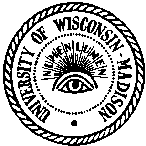|
|
Instructor, R. S. Lakes
Text: B. D. Agarwal and L. J. Broutman, Analysis and Performance of Fiber Composites, J. Wiley, 2nd ed. (1990).
References [On reserve]
L. J. Gibson, and M. F. Ashby, Cellular Solids, Pergamon, (1988).
R.M. Christensen, Mechanics of Composite Materials, J. Wiley, 2nd ed. (1979).
M. Taya and R. J. Arsenault, Metal Matrix Composites, Pergamon, NY, 1989.

Description
Principles of the mechanics of solid multiphase systems; applications in lightweight structures, ultrastrong materials, materials for protection
of the body, and materials for the replacement of human tissues; composites with fibrous, lamellar, particulate, and cellular structures; composite
materials of biological origin.
Topics; Reading
I: Introduction. Rationale for composites, strength of fibers. Constituent materials. Agarwal
& Broutman Ch. 1, 2. Griffith's experiments, stress concentrations. Gibson & Ashby Ch. 1. Concept of equivalent homogeneity. Taya and Arsenault Ch. 1. Composite structures-laminated, fibrous, particulate, cellular and porous, platelet structures. Biological composite materials.
II: Unidirectional fibrous media. Agarwal & Broutman Ch. 3. Prediction of stiffness and strength for different directions. Christensen ¤4.1. Voigt and Reuss bounds on the moduli; viscoelastic composites. Fibrous aspects of bone structure. Tendon and ligament as fibrous biological materials. Micromechanics of fibrous materials.
III: Short-fiber composites. Agarwal & Broutman Ch. 4. Shear lag model. Applications in biomaterials. Automotive and structural applications.
IV: Application of anisotropic elasticity to composites. Agarwal & Broutman Ch. 5. Generalized Hooke's law. Tensor notation. [Taya and Arsenault ¤2.3] Symmetry classes: triclinic, monoclinic, orthotropic, hexagonal, cubic, isotropic.
V: Laminates. Agarwal & Broutman Ch. 5,6. Lamination theory. [Taya and Arsenault ¤2.4.3]
VI: Cellular solids. Gibson & Ashby Ch. 2,4,5. Structure property relations of cellular solids. Cellular solids for protection. Lightweight cellular solids. Biological cellular solids. Bone, wood, bamboo.
VII: Particle and platelet composites. Christensen Ch. 2, ¤4.5. Stiffness vs. volume fraction, dental composites, metal matrix composites.
VIII: Micromechanics Handout material, Generalized continuum models; Cosserat elasticity. Agarwal & Broutman Ch. 7. Toughness: Whitney-Nuismer criteria; causal mechanisms
IX: Design considerations Christensen Ch. 6. Fracture mechanics, stress concentrations, free-edge effects. Examples: Fiber reinforced pressure vessel, flywheel, bone cement. Applications of cellular solids.
X: Viscoelasticity Christensen ¤1.2. Creep, relaxation, vibration damping. Taya and Arsenault ¤4.2 Bounds on stiffness-loss map. Fiber and matrix dominated behavior. Gibson & Ashby ¤3.2,6.2
XI: Experimental methods Agarwal & Broutman Ch. 9.